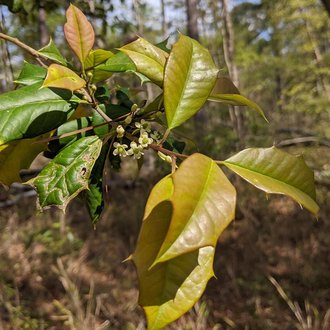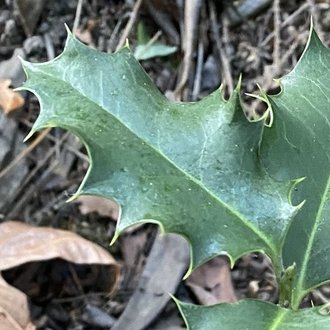American Holly vs European Holly
These two broadleaf evergreen trees with spiny leaves are often confused, mainly in landscaping in the east. They are easily distinguished by their foliage, and they also have differences in fruit. In the east, European holly is rare outside of landscaping, but in the west it is widely invasive; American holly is native in the east and not found in the west.
American Holly (Ilex opaca) | European Holly (Ilex aquifolium) |
A broadleaf evergreen tree that has the most northerly distribution of any broadleaf evergreen tree in North America; among other evergreen plants, only smaller shrubs and conifers persist farther north. Common and widespread in much of its range. | An evergreen tree native to Europe, widely established on the west coast of North America, where it can be invasive, and established on a few sites in the east as well. |
Foliage is dull. Photo © Jody Shugart, CC BY 4.0. | Foliage is shiny or glossy. Photo © eralverson, CC BY 4.0. |
Duller fruits solitary or on solitary stalks proceding directly from the twigs of the current season's growth. Photo © , CC BY-SA 4.0. | Shinier fruits usually in clusters, only occasionally solitary, produced in the axils of the previous season's growth. Photo © eralverson, CC BY 4.0. |
Spines occasionally (not always) decrease higher up on tree, but usually all leaves still have spines. Pictured leaves here have unusually few spines for this species. Photo © Austin Pursley, Public Domain. | Spines per leaf often decrease markedly towards the top of mature trees, to where some leaves on upper branches may be completely free of spines. Photo © Randal, Public Domain. |
Spines firmer, more painful if they poke you. Leaf surface tapers less to each spine, and leaf margins are straighter between spines. Photo © Andrew Conboy, CC BY 4.0. | Spines softer, less painful if they poke you. Leaf surface tapers more to each spine, and leaf margins are more curved between spines. Photo © Chris Armstrong, Public Domain. |
References & External Resources
These short lists show only links helpful for ID. For a complete list of references and resources also covering other aspects of ecology, visit the links section of the full article on each plant, which is the first entry here.










